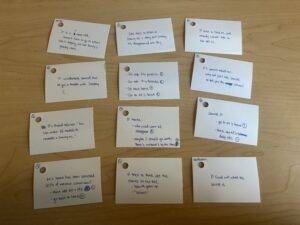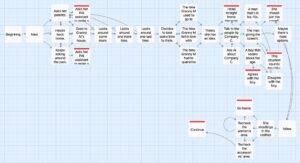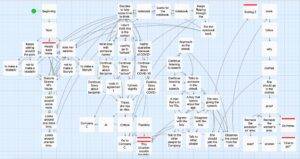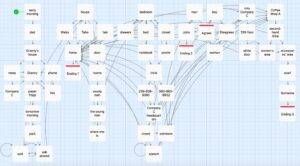Link to Game: https://00grace00.itch.io/2072
Overview:
2072 is an interactive fiction game developed in Twine. The game originates from a conversation between my dad and me, where my dad warns me against the risk of AI overtaking jobs in the future. However, I, instead, believe that AI will remain a tool that humans can use for good or bad. Hence, I wondered what the future would look like if AI was not monitored correctly. This story begins in an imaginary world in 2072, with AI so prevalent that people can’t imagine life without it. An 11-year-old girl, in her journey to look for her granny, interacts with people with different perspectives on AI. Through this story, the little girl realizes the harm of monopoly and identifies the harm brought by humans behind the AI tools, instead of the danger of AI.
History Versions of Game and Game Testing:
The game started with a simple, paper prototype. Initially, the plot is very simple. A little girl needs to find her granny, whose disappearance seems to be connected with a company. Although never finding her granny, the little girl learns that the company is systematically getting rid of people who stand opposite to the company. With this prototype, the game lacks any connection that would bring the main character to the company. 
As the story was moved onto Twine, more details were thought out. The stories that Granny told the little girl can hold beliefs that Granny holds toward AI and the company. While being around the company, the little girl may also find others who stand against the company, hence learning more about the cause of her granny’s disappearance. In this draft, no names have been assigned, yet. The main character is referred to as “P”, her granny as “Granny M”, and the company as “Company C”.
Playtest 1
The first playtest was conducted in class with a female player. She seemed to be immersed in the stories that Granny M told, feeling sad about Granny M’s lost love and chuckling a little as she read about Granny M’s experience of quarantining during COVID-19. She identified the tone of the story as conspiracy, and exclaimed that she “loved it.” The player also pinpointed the game’s long passages, identifying that while it is still readable, the paragraphs can be hard to focus on. As a result of this playtest, the passages were reduced to the length of one page.

Playtest 2
The second playtest was conducted shortly after the first one, also in class. Another female player, who has worked with me in previous game development, playtested the game. The player, unlike the first player, seemed to skim the paragraphs and click as fast as she could. She still seems to pay attention to some details, such as exclaiming “There’s no school?!” when reading about P’s background, but it is unknown how many details were lost during the quick scrolling. This player also reported interest in the game, claiming that she “[likes] the different options.”
When asked for improvements, the player also talked about the length of the texts. There seemed to be a lot of texts, and some seemed irrelevant to the story. There were some words that she would like to know more about, but the option was not offered. While the player was reading the story, she mentioned that she felt more like an observer of events, instead of an actor. She would like more choices that can influence the story. Last but not least, she felt that there was not a lot of connection between Granny M and Company C. She thought that more evidence of Granny M leading the protest movement may help with the flow of the story.
As a result of this playtest, some words, such as Company C, were highlighted in the story for players to interact with and get to know more about. More branches were provided in the story. As a way to make the story more engaging, players now have options to skip the stories that Granny M tells if they choose to do so. Some variables were set in the story to allow some different routes, and certain choices cannot be made if a certain variable is not within the designated scope. To make the story more interesting, the characters, P and Granny M, were named by the players.

Playtest 3
The third playtest was conducted with my roommate. This third female player again highlighted the length of Granny M’s stories. She also expressed her slight annoyance of having to go through all three stories to move on with the plot. A few code-related mistakes were made with this version of the game, and the player happened to experience most of them. An example was the misuse of else: statement.
As a result of this playtest, Granny M’s stories were altered so that all three stories have an AI-related element. The code problems were also resolved, and a few additional variables were set to help with the flow of the story.
Playtest 4
The fourth playtest was conducted with another female player during class. The player identified the story as mysterious and expressed her wish for this story to include more mysteries. She mentioned the possibility of pacing the paragraphs and the length of the text. A story link was misnamed, which caused a little confusion during the playtest. During the playtest, I also noticed how most players seemed to choose one route over another, which, because the route is a newly developed one, caused some loss of details. This player also mentioned being emotionally distant from Granny M, which leads her to head home whenever the choices appear.
As a result of this playtest, I thought about reconstructing the story plot. Because the different routes in the story were written at different times, there was less coherency between routes, which can cause some confusion to the players. Some kind of beginning, it seems, is essential for the player to feel emotionally connected with the grandma and hence want to go look for her.

Playtest 5&6
Two playtests were conducted in class before any big changes could be made. The two playtesters were the instructor and the teaching assistant of the class. While playtesting the game, the instructor mentioned being confused about the story due to the gap between different routes, again strengthening my urge to rewrite the story. She also mentioned that, due to the age of the main character, the little girl may rely on her parents a lot, which is something I became more mindful of when I created the choices in the new story. The warning of Company C, which appeared by the end of the story, was not obvious enough, and the idea of ripping a family picture was proposed.
While playtesting, the teaching assistant of the class again pointed out that the text was too lengthy. It was suggested that certain codes can be implemented to help players facilitate the pacing of the story.
Playtest 7
After these playtests, I found time to reorganize my story. A beginning with Granny M was added, in which a promise (to meet at the park in the next morning) was made with the little girl, adding some reasons for the little girl’s concern. Some characters were added to the story to enrich the story. Certain choices were added to the story, and the player’s decision now influenced the characters that the little girl may run into. Granny M’s stories were taken out of the plot because of their inconsistencies with the general flow of the plot. Codes for pacing were added to the story, and the player now can choose to go back home at almost any time. This game is now officially settled on having five endings.
After the new story had been developed, another playtest was conducted with a friend at USC. In general, she responded positively, claiming that she likes how the game portrays some extent of reality. Specifically, she mentioned that it is very realistic that the parents don’t directly tell the little girl what really happened. She enjoyed the constructed world of this story, thinking that it could be a fun worldview to play within a short novel.
Despite the positive feedback, some issues came up in the playtest. A few mistakes with if: statements were identified, and I reorganized the timeline of the characters’ appearances to avoid mistakes. The conversations with Granny M when the main character first entered the house sounded odd. While playtesting, I also began to question the educational value of my game. I was uncertain whether my goal was to question AI’s presence or monopolies.
Playtest 8&9
Bringing my questions to class, I conducted two more playtests with the instructor and the teaching assistant. Testing the game, the instructor questioned why a character offered to meet the main character at a coffee shop but was not offered the choice. She also prompted me to think about what is wrong with monopolies and what might be some ways to show off the problems. Excited to learn about the different endings, the instructor mentioned the difficulty for repeat play of the game due to the lack of checkpoints. Due to the bulk of my code, some code-related mistakes were also identified, such as the removal of one choice in the middle of game playing. These mistakes were fixed on the spot.
While the teaching assistant was playing the game, she seemed to be engaging. For example, she gasped when the main character was facing the gun, and she exclaimed “How DO I feel about the color green?” when the little girl was asked this question a second time. She expressed liking the options of waiting at the park and how her choices can lead to different branches of the story. When asked for suggestions, the teaching assistant encouraged more uses of AI, since the story takes place in an AI-heavy world. She also suggested providing an actual time for Company C to enhance the realisticness of the story.
Playtest 10
During the same class session, one of my classmates also played my game. Some minor mistakes were noted during the playtest, such as the sudden appearance of a phone number without going through the correct plotlines. This mistake was quickly fixed on the spot.
Playtest 11
About the same time, a playtest was conducted asynchronously with a friend at Harvard University. Overall, he responded to the story as “very interesting”. However, he was a little confused about the plot. For example, the ending he arrived at (Ending 3) seems to be disconnected from the plot that leads toward it.

Final Version
Finally, the story now evolves to what it looks like now. The endings were named differently in the stories to avoid cutting the flow of the story. Ending 3, specifically, was rewritten to provide a smoother ending. Company C now has been named AetherTech. While maintaining the plot structure, details of the characters using AI and the influence of AetherTech were added to the story. As part of the ending, a variable was added to show the players how many endings they have arrived at, and an option to go back to where the storyline branches off was added to improve replayability.

Reflection:
As the first interactive fiction game and most likely the first full-fledged story I have developed, 2072 is surprisingly long for me as the creator. I am excited by the divergent thinking that the story has encouraged me to practice while developing the game. I also found that game development is an interesting process for me to practice taking other people’s perspectives. While playtesting my game, I was happy to find that my game is promoting the wanted emotion and responses in players and was simultaneously surprised by some of the emotions that brewed in people.
With this experience, I learned that games and stories are often developed with some kind of arguments or intentions behind them. While developing this game, I found myself questioning every piece that I interacted with, wondering how the stories I have read may have influenced my thinking in different ways.
If I were to develop another interactive fiction, I would probably pinpoint my intention early. I found out that it is easier to construct a world if the intention is decided early. I am thankful for the ease of creating interactive fiction using Twine, and I would like to try my hands on more game developments.

